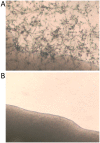First reported case of Cryptococcus gattii in the Southeastern USA: implications for travel-associated acquisition of an emerging pathogen
- PMID: 19516904
- PMCID: PMC2689935
- DOI: 10.1371/journal.pone.0005851
First reported case of Cryptococcus gattii in the Southeastern USA: implications for travel-associated acquisition of an emerging pathogen
Abstract
In 2007, the first confirmed case of Cryptococcus gattii was reported in the state of North Carolina, USA. An otherwise healthy HIV negative male patient presented with a large upper thigh cryptococcoma in February, which was surgically removed and the patient was started on long-term high-dose fluconazole treatment. In May of 2007, the patient presented to the Duke University hospital emergency room with seizures. Magnetic resonance imaging revealed two large CNS lesions found to be cryptococcomas based on brain biopsy. Prior chest CT imaging had revealed small lung nodules indicating that C. gattii spores or desiccated yeast were likely inhaled into the lungs and dissemination occurred to both the leg and CNS. The patient's travel history included a visit throughout the San Francisco, CA region in September through October of 2006, consistent with acquisition during this time period. Cultures from both the leg and brain biopsies were subjected to analysis. Based on phenotypic and molecular methods, both isolates were C. gattii, VGI molecular type, and distinct from the Vancouver Island outbreak isolates. Based on multilocus sequence typing of coding and noncoding regions and virulence in a heterologous host model, the leg and brain isolates are identical, but the two differed in mating fertility. Two clinical isolates, one from a transplant recipient in San Francisco and the other from Australia, were identical to the North Carolina clinical isolate at all markers tested. Closely related isolates that differ at only one or a few noncoding markers are present in the Australian environment. Taken together, these findings support a model in which C. gattii VGI was transferred from Australia to California, possibly though an association with its common host plant E. camaldulensis, and the patient was exposed in San Francisco and returned to present with disease in North Carolina.
Conflict of interest statement
Figures







Similar articles
-
Genotype and mating type analysis of Cryptococcus neoformans and Cryptococcus gattii isolates from China that mainly originated from non-HIV-infected patients.FEMS Yeast Res. 2008 Sep;8(6):930-8. doi: 10.1111/j.1567-1364.2008.00422.x. Epub 2008 Jul 29. FEMS Yeast Res. 2008. PMID: 18671745
-
Cryptococcus deuterogattii VGIIa Infection Associated with Travel to the Pacific Northwest Outbreak Region in an Anti-Granulocyte-Macrophage Colony-Stimulating Factor Autoantibody-Positive Patient in the United States.mBio. 2019 Feb 12;10(1):e02733-18. doi: 10.1128/mBio.02733-18. mBio. 2019. PMID: 30755511 Free PMC article.
-
A rare genotype of Cryptococcus gattii caused the cryptococcosis outbreak on Vancouver Island (British Columbia, Canada).Proc Natl Acad Sci U S A. 2004 Dec 7;101(49):17258-63. doi: 10.1073/pnas.0402981101. Epub 2004 Nov 30. Proc Natl Acad Sci U S A. 2004. PMID: 15572442 Free PMC article.
-
The Disease Ecology, Epidemiology, Clinical Manifestations, and Management of Emerging Cryptococcus gattii Complex Infections.Wilderness Environ Med. 2020 Mar;31(1):101-109. doi: 10.1016/j.wem.2019.10.004. Epub 2019 Dec 6. Wilderness Environ Med. 2020. PMID: 31813737 Review.
-
Disseminated Cryptococcus deuterogattii (AFLP6/VGII) infection in an Arabian horse from Dubai, United Arab Emirates.Rev Iberoam Micol. 2017 Oct-Dec;34(4):229-232. doi: 10.1016/j.riam.2017.02.007. Epub 2017 Jun 7. Rev Iberoam Micol. 2017. PMID: 28595777 Review.
Cited by
-
Cryptococcus gattii genotype VGI infection in New England.Pediatr Infect Dis J. 2011 Dec;30(12):1111-4. doi: 10.1097/INF.0b013e31822d14fd. Pediatr Infect Dis J. 2011. PMID: 21814154 Free PMC article.
-
Global Molecular Epidemiology of Cryptococcus neoformans and Cryptococcus gattii: An Atlas of the Molecular Types.Scientifica (Cairo). 2013;2013:675213. doi: 10.1155/2013/675213. Epub 2013 Jan 9. Scientifica (Cairo). 2013. PMID: 24278784 Free PMC article. Review.
-
A case of Cryptococcus gattii infection in South Carolina: A possible challenge to known endemicity.IDCases. 2020 Dec 17;23:e01027. doi: 10.1016/j.idcr.2020.e01027. eCollection 2021. IDCases. 2020. PMID: 33425680 Free PMC article.
-
Pathogenic diversity amongst serotype C VGIII and VGIV Cryptococcus gattii isolates.Sci Rep. 2015 Jul 8;5:11717. doi: 10.1038/srep11717. Sci Rep. 2015. PMID: 26153364 Free PMC article.
-
Cryptococcus gattii infections.Clin Microbiol Rev. 2014 Oct;27(4):980-1024. doi: 10.1128/CMR.00126-13. Clin Microbiol Rev. 2014. PMID: 25278580 Free PMC article. Review.
References
-
- King DA, Peckham C, Waage JK, Brownlie J, Woolhouse ME. Epidemiology. Infectious diseases: preparing for the future. Science. 2006;313:1392–1393. - PubMed
-
- Cohen ML. Changing patterns of infectious disease. Nature. 2000;406:762–767. - PubMed
-
- Perfect JR, Casadevall A. Fungal molecular pathogenesis: What can it do and why do we need it? In: Heitman J, Filler S, Edwards J, Mitchell A, editors. Molecular Principals of Fungal Pathogenesis. ASM Press; 2006.
Publication types
MeSH terms
Grants and funding
LinkOut - more resources
Full Text Sources

